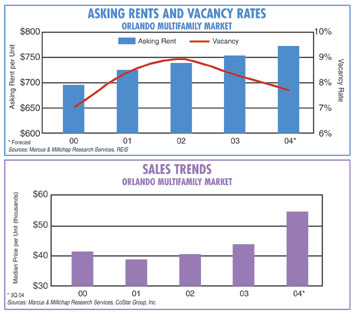|
SOUTHEAST SNAPSHOT, NOVEMBER 2004
Orlando Multifamily Market
 |
|
Steven Ekovich
First Vice President
Marcus & Millichap
|
|
The Orlando, Florida, apartment market is gaining steam due
to strong renter demographics and a revived and bustling economy.
Improvements in fundamentals and a restrained construction
cycle have come together to raise investor interest in multifamily
acquisitions. Both local and national buyers are attracted
to multifamily properties that serve workers in Orlando’s
business services community in the Maitland area as well as
those located in submarkets to the south, which house the
theme parks’ expanding work force. This has resulted
in record-high prices for multifamily assets.
Metro-area apartment owners are benefiting from recent job
growth as many new employees are becoming first-time renters.
Local employers are on target to add 25,000 new positions
by the end of 2004, representing a 2.7 percent increase in
total area jobs. Leisure and hospitality sector payrolls are
on pace to grow by more than 20,000 employees by the end of
2004. Strong growth in business and professional services
and financial activities is concentrated in the office complexes
and corporate headquarters along the Interstate 4 corridor
north of Orlando, particularly in the Maitland area north
of downtown Orlando. Multifamily properties in the northern
suburb of Maitland continue to attract renters who wish to
live near their white-collar jobs.
Multifamily construction in the Orlando area has slowed
significantly when compared to recent years, and developers
will complete only 2,250 units this year. Together, the Southeast/Airport
and the Southwest/435 submarkets will account for half of
2004’s completion total. Developers are attracted to
these regions due to accessibility to theme parks to the south
of the Orlando central business district. There are more than
5,000 units filling the construction pipeline, the majority
of which are located in the southern portion of the metro
area. When delivered, the apartment inventory will have grown
by 4 percent, which is high by most metro standards, but will
be easily absorbed in Orlando where in-migration forecasts
are strong. More than half of the local construction volume
is made up of affordable apartment product rather than Class
A multifamily units.

The average asking rent in the Orlando area is on target to
increase $23 in 2004 to $778 per month. Although local market
rents are low compared to other Eastern seaboard cities, rent
growth is occurring more rapidly. Submarkets with the highest
rents in Orlando are those in close proximity to the major
employment centers. Areas near theme parks support rents as
high $919 per month. Residents near the Maitland Office Park
attract residents willing to pay an average of $800 per month.
This year, the most significant rent growth — 4.4 percent
— is found in the Southwest/435 corridor, adjacent to
Disney’s property. Effective rents are beginning to gain
momentum as increases will be recorded in every Orlando submarket
by year-end.
Occupancy is rebounding strongly in Orlando and should improve
by another 60 basis points to end the year at a metro-wide
average of 92.3 percent. Gains in occupancy are the result
of stronger demand associated with an increase in local in-migration
and higher employment growth. Demand is outpacing new deliveries
and, as a result, absorption is on track to measure more than
2,900 units in 2004. The highest occupancy rates in the region
are found in the more mature submarkets to the north, such
as West Altamonte Springs and Northeast/ 436/551. Higher rates
of absorption, however, are found in the apartment communities
to the south where tourist-based employment is centered and
where the majority of available developable land is located.
After a slightly negative trend over the past 3 years, the
median sales price in Orlando is on track to increase by more
than 20 percent, to $52,000 per unit, by year-end. The $5
million-and-greater segment of the market is accounting for
a larger share of activity than usual, with sales of garden-style
properties containing more than 200 units being the rule rather
than the exception. This has prompted many sellers to put
together portfolios that are being greeted with strong interest
from out-of-state investors.
— Steven Ekovich, first vice president and regional
manager, Marcus & Millichap’s Orlando office
©2004 France Publications, Inc. Duplication
or reproduction of this article not permitted without authorization
from France Publications, Inc. For information on reprints
of this article contact Barbara
Sherer at (630) 554-6054.
|
